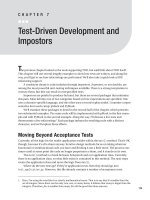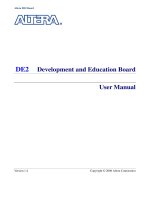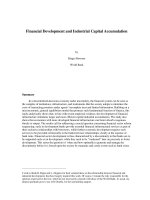Microsatellite marker development and characte
Bạn đang xem bản rút gọn của tài liệu. Xem và tải ngay bản đầy đủ của tài liệu tại đây (461.44 KB, 6 trang )
International Journal of Aquaculture 2012, Vol.2, No.2, 5-10
A Letter
Open Access
Microsatellite Marker Development and Characterization in the Spotted Babylon,
Babylonia areolata (Link, 1807): Detection of Duplicated Loci at High Frequency
Nan Zhang* , Ying Qiu* , Xuzhen Huang , Xuefen Chen , Aimin Wang , Yan Wang
Key Laboratory of Tropical Biological Resources of Ministry of Education, Hainan Provincial Key Laboratory of Tropical Hydrobiology and Biotechnology,
Marine Biology Experiment Teaching Demonstration Center, Ocean College, Hainan University, 58 Renmin Rd, Haikou, 570228, P.R. China
Corresponding authors email: ;
Authors
* The authors who contribute equally
International Journal of Aquaculture, 2012, Vol.2, No.2 doi: 10.5376/ija.2012.02.0002
Received: 15 Mar., 2012
Accepted: 06 Apr., 2012
Published: 11 May, 2012
This is an open access article published under the terms of the Creative Commons Attribution License, which permits unrestricted use, distribution, and reproduction
in any medium, provided the original work is properly cited.
Preferred citation for this article:
Zhang et al., 2012, Microsatellite Marker Development and Characterization in the Spotted Babylon, Babylonia areolata (Link, 1807): Detection of Duplicated
Loci at High Frequency, International Journal of Aquaculture, Vol.2, No.2 5-10 (doi: 10.5376/ija.2012. 02.0002)
Abstract Four polymorphic microsatellite markers were developed for the spotted babylon, Babylonia areolata, from a
microsatellite enriched library. Those markers, characterized in 32 individuals from one wild population, were polymorphic with
allele numbers ranging from 5 to 15 per locus, expected and observed heterozygosity ranging from 0.60 to 0.92 and from 0.36 to 0.88,
respectively. One locus showed significant (p<0.05 after Bonferroni correction) deviation from Hardy–Weinberg equilibrium,
probably due to the presence of null alleles. These microsatellite markers should be useful for population genetics studies in this
species. In addition, nine primer pairs amplified duplicated microsatellites, with four multiple loci clearly linked in tandem, which
provides a good opportunity to study the evolution of repetitive DNA sequences in the genome.
Keywords Babylonia areolata; Microsatellites; Duplicated loci; Population genetics; Fishery; Gastropod; Spotted Babylon y
structure and variation in this species (Hualkasin et al.,
2008; Wang et al., 2011a). To support population
structure analyses and facilitate stock management
(Wang et al., 2010b), we developed a microsatellite
enriched library and characterized 4 novel polymorphic
microsatellite markers for the spotted babylon. In
addition, we found high percentage of duplicated
microsatellites clearly linked in tandem, which
provides a good opportunity to study the evolution of
repetitive DNA sequences in the genome though these
multi-locus microsatellites may not be suitable for
using as genetic markers because it is often
impossible to discern the locus-specific alleles
(Zhang, 2004).
Introduction
The spotted babylon Babylonia areolata (Link, 1807),
also called maculated ivory whelk, is a marine
gastropod mollusc distributed in southeastern Asia. Its
geographic distribution stretches from Ceylon and
Nicobar Islands through the Gulf of Thailand, along
Vietnamese and Chinese coasts to Taiwan (Altena and
Gittenberger, 1981). It is mostly found on mud and
sandy littoral bottoms not exceeding 5~10 m in depth
(Panichasuk, 1996). The spotted babylon is a popular
model mollusk used in studies on heavy-metal toxicity
and biologic poisoning toxins transmission studies
(Chen and Chou, 1998; Supanopas et al., 2005;
Tanhan et al., 2005) since its being the popular and
nutritious seafood. Recent years the wild populations
have declined rapidly duo to fast-growing demand for
consumption and environmental pollution. The spotted
babylon has been a commercially important aquaculture
species in Thailand (Chaitanawisuti et al., 2002;
Kritsanapuntu et al., 2006) and China (Liang et al.,
2005). The individuals from Thailand have greater
growth vigor than native ones in Hainan Island, so
most hatchery populations in Hainan come from
Thailand lines. But little is known about the genetic
1 Results
1.1 Microsatellite sequences
One hundred and twenty-eight positive clones were
sequenced, producing a total of 59 252 bp of DNA
sequences. Analysis with MISA identified 118
microsatellite-containing sequences, corresponding to
an enrichment efficiency of 97.5%. The 118
microsatellite-containing sequences harbored 406
microsatellites with di- (85.5%), tri- (4.2%), tetra(6.2%), penta- (0.7%), hexa- (1.7%), and hepata5
International Journal of Aquaculture 2012, Vol.2, No.2, 5-10
numbers ranging from 5 to 15 per locus (mean, 11±4.55).
The expected and observed heterozygosity ranged
from 0.60 to 0.92 (mean, 0.79±0.14) and from 0.52 to
0.90 (mean, 0.67±0.24), respectively (Table 1). No
linkage disequilibrium was detected among all the loci
at p>0.05 (after Bonferroni correction). One locus
(HUBA07) showed significant (p<0.05 after Bonferroni
correction) deviation from Hardy–Weinberg equilibrium.
HUBA10 showed signs of null alleles as indicated by
Micro-checker (1 000 randomizations) (Table 1),
suggesting that the presence of null alleles is the main
cause for the deviation from HWE at these loci. The
four microsatellite markers developed here should be
useful for population genetics studies in this species.
(1.7%) repeats. Ninety (76.3%) sequences contained
more than one microsatellite. But most of these
sequence contained clustered and complex repeated
structures, only fifty-six sequences had sufficient
flanking regions for primer designing.
1.2 Amplification and polymorphism
Thirteen primer pairs showed reliable and reproducible
amplification in 32 wild individuals. Sequences of
these 13 microsatellites were submitted to GenBank
(accession numbers FJ594998 – FJ595016). Four of the
13 primer pairs produced no more than 2 alleles per
individual and were considered valid single-locus
microsatellite markers (Table 1). The 4 single-locus
microsatellite loci were polymorphic with allele
Table 1 Primer sequences and characteristics of 8 Babylonia areolata single-locus microsatellite markers
Locus
GenBank
Repeat motif §
Primer sequences (5'-3')
acc. no.
HUBA01
FJ594998 (TG)n
F: tgtgacatgaacaagggacttc
Ta
MgCl2 n
a
as
(℃)
(mM)
62
1.2
30 10 302-340 0.92 0.88 0.056
60
1.2
27 15 219-309 0.60 0.36 0.006
58
2.0
31 5
60
1.5
29 14 390-430 0.76 0.84 0.025
HE
HO
PHWE
R: aggaaactcagagcattcgtg
HUBA07† FJ595004 (AG)N(TG)N
F: aaaagtgcttctcgtgcattg
R: aacttgtctctttcggggaac
HUBA10† FJ595007 (TG)N(AG n
F: atctccgtcgtcttgtgattg
380-450 0.87 0.60 0.023
R: tgctggtattcagtcctgtcc
HUBA18
FJ595015 (TC)N(TTC)N(GTG)N
F: tacgacgtgtttgacgtgttg
R: tgacctcacgcaagaaaagag
Note: The number of individual analyzed (n), number of alleles (a), allele size range in base pairs (as), observed (HO) and expected
(HE) heterozygosities are presented for each locus. Ta is the annealing temperature and PHWE is the probability of Hardy–Weinberg
equilibrium. §Repeat motif: N, pure; n, interrupted; Values in bold represent significant probability estimates after correction for
Bonferroni multiple tests (initialα< 0.05/5 = 0.01); †Loci showing evidence for null alleles suggested by Micro-Checker
locus-to-locus distance of about 145 bp (Figure 1).
This can be explained by the model of [forward
primer] - 145 bp- [forward primer] -267 bp - (8 bp) n[reverse primer]. This finding implies that one of the
primers sequence may be located within a satellite
near the microsatellite loci so that there is significant
tandem duplication of microsatellite loci and/or their
flanking sequences in B. areolata genome.
1.3 Duplicated loci
The remaining nine (69%, 9 of 13) duplicated loci
amplified more than 2 alleles in most individual
(Table 2).
The extra alleles can not be eliminated through
increasing amplification stringency (lower Mg2+
concentration and higher annealing temperature),
suggesting that they were not caused by nonspecific
amplification, but by amplification of duplicated loci.
Four (30.8%, 4 of 13 ) of them amplified 2 to 4
parallel loci per individual between 100 and 550 bp,
which were clearly linked in tandem as they were
separated in well-defined patterns. For example,
HUBA02 amplified unambiguous non-overlapping
two parallel loci linked obviously, one to two
fragments that differed by 8n bp per locus, with a
2 Discussion
Those 4 duplicated loci amplified parallel loci
separated in well-defined pattern observed in this
study were similar to those microsatellite loci that
were linked in tandem with duplicated structures, e.g.
satellites or mini-satellite sequences found in Atlantic
surfclam, Spisula solidissima (6.7%, 2 of 30) (Wang et
al., 2009b), white-lipped pearl oyster, Pinctada
6
International Journal of Aquaculture 2012, Vol.2, No.2, 5-10
reported in any mollusk. This finding implies that the
complex duplications of B. areolata genome are
partly characterized by overlapping and/or linkage
in tandem of microsatellites, mini-satellites and
satellites.
maxima (11.1%, 2 of 18) (Wang et al., 2009a), and
hard clam Mercenaria mercenaria (21.2%, 11/52)
(Wang et al., 2010a). As far as we can determine, high
frequency of duplicated locus linked in tandem such
as the 30.8% observed in this study has not been
Table 2 Information of nine Babylonia areolata duplicated loci
Locus
GenBank acc. no.
Repeat motif §
Primer sequences (5'-3')
Ta(℃)
MgCl2 (mM)
as
n
HUBA02*
FJ594999
(AC)N(CT)N
F: taggtgcaggccatatcagag
62
1.5
275-444
32
HUBA04
FJ595001
(GT)N
60
1.5
191-311
32
HUBA05
FJ595002
(GT)n(GA)N
62
1.5
271-451
32
HUBA06*
FJ595003
(CA)N(TCA)N
50
1.5
404-551
32
HUBA11*
FJ595008
(GT)N(CT)n
61
1.5
286-414
32
HUBA12
FJ595009
(GACA)N(GA n
60
1.5
277-425
30
HUBA14
FJ595011
(AC)N
60
1.5
195-285
31
HUBA16*
FJ595013
(AC)N
60
2.0
166-278
29
HUBA19
FJ595016
(TG)n
53
2.0
242-508
32
R: gtgaaacggtcaaatgttcaag
F: gatcacgatttgaaagactgaaag
R: cggaacttgcaacatttaacac
F: aagctcgttcaacttcacgtc
R: gatcaatccgctgtctttctg
F: atcgccacaatgacaatcaac
F: actggatgatgcgatgacaac
F: gaaacttcaaacgacaccaaac
R: gaaagagacgaagggtggaag
F: agtacgggtttcttctttgctc
R: agcctgcgaatctgattactg
F: tgccaaatttgttgtcaactg
R: cttccgtcaacagtgaccttg
F: tgcctaatttggtgtcaactg
R: cttgctttcggtcactttttg
F: ttttctgcacatgaagaaccac
R: aaaaacctccaccctttaccc
Note: The number of individuals analyzed (n), allele size across multi-locus range in base pairs (as) are presented. §Repeat motif: N,
pure; n, interrupted; *duplicated loci amplified parallel loci clearly linked in tandem
results suggested that the B. areolata genome may be
a good model to study the evolution of genome
duplication in mollusk.
There probably is high frequency of microsatellite
sequences in B. areolata genomes, since we obtained
an enrichment efficiency of 97.5% (118 of 121) in this
study, which is much higher than that obtained in
other four molluscan species whose microsatellite
markers were developed in parallel in our laboratory
using the same protocol and reagents: 63.3% for
Spisula solidissima (Wang et al., 2009b), 53.2% for
Pinctada maxima (Wang et al., 2009a), 59.4% for
Mercenaria mercenaria (Wang et al., 2010a), and
58.5% for Haliotis diversicolor (Wang et al., 2011c).
Extraordinarily, there are sixty-two microsatellite
sequences (52.5%, 62 out of 118) contained too long
and complex microsatellites to have sufficient
flanking regions for primer designing, such high
frequency was also reported in B. areolata (Chen et al.,
2009; Wang et al., 2011a) and other whelk e.g.
Buccinum undatum (Weetman et al., 2005). These
The 4 polymorphic microsatellite markers developed
here are useful addition to the collection of other
molecular markers that are now available for B.
areolata, including mitochondrial markers and other
microsatellites markers (Chen et al., 2009; Wang et al.,
2011a). They will prove valuable for future population
genetic studies and in tracking of hatchery strains in
this species.
The finding of significant proportions of locus
duplication suggests that the use and isolation of
microsatellite markers in B. areolata may be
challenging. Perhaps further efforts in this species
should be directed to the development of SNP markers
based on the second generation sequencing technology.
7
International Journal of Aquaculture 2012
column (Pall, CA, USA). DNA fragments with
adapters were amplified with linker B for 5 PCR
cycles and purified using an Ultrafree column (Pall).
The amplified products were denatured and then
hybridized to biotin-labeled (CA)12, (GA)12, (ACA)8,
(AGA) 8 , (GACA) 6 and (GATA) 6 oligonucleotides
(mixed in advance at the ratio of 3:1:1:1:2:2, total 150
pmol) in 0.5×SSC at 68℃ for 60 min. Washed four
times in 0.1×SSC at room temperature, DNA
fragments bound to these probes were then captured
with Streptavidin MagneSphere® Paramagnetic
Particles (Promega, USA) and eluted by DNase-free
water. The microsatellite-enriched elution was amplified
and purified as described above. The amplified
products were cloned using the T-Easy system
(Promega). Clones containing potential microsatellite
loci were selected and sequenced on ABI 3730xl DNA
analyzers at Sangon Biological Engineering Technology
& Services Co., Ltd. (Shanghai, China).
3.3 Primer design and genotyping
DNA sequences removed the linkers and T vector
were searched against each other and against 17
spotted babylon microsatellite sequences from
GenBank (accessed March 19, 2012) using Vector
NTI Advance 11.0.0 () to
check for duplicates. Microsatellite sequences containing
at least 6 di-, 5 tri-, 5 tetra-, 4 penta-, and 3 hexa-,
hepta- and octanucleotide repeats were selected using
MISA software ( />Good sequences with sufficient flanking regions were
used for primer design with Primer3 (http://biotools.
umassmed.edu/bioapps/primer3_www.cgi). An M13
(-21) universal leading sequence (5-TGTAAAACGA
CGGCCAGT-3) was added to the 5' end of each
forward primer (Schuelke, 2000), and primers were
synthesized by Sangon Biological Engineering
Technology & Services Co., Ltd (Shanghai, China).
Figure 1 PCR amplifying fragments of duplicated loci HUBA02
in 4 Babylonia areolata individuals shown by GeneMapper 3.5
software
3 Materials and Methods
3.1 Samples and DNA extraction
Thirty-two B. areolata individuals were collected
from a wild population at the seashore near Qiaogang
town of Beihai city, Guanxi Province, China. DNA
was extracted from the ethanol preserved gastropod
muscles using the Cell/Tissue Genomic DNA Extraction
Kit (TianGen, Beijing, China) (Lu et al., 2011).
3.2 Microsatellite-enriched library construction and
sequencing
A microsatellite-enriched DNA library was constructed
using a selective hybridization and magnetic bead
enrichment protocol as described in Wang et al
(2010a). Briefly, about 38 µg genomic DNA of three
individuals was digested by the restriction enzyme
Mbo I (TaKaRa, Dalian, China). Fragments of
300~1 000 bp collected with the Gel DNA Extraction
Kit (TianGen) were ligated to double stranded Mbo I
adapters by incubating with T4 DNA ligase (TaKaRa)
at 16℃ overnight. Excess adapters were removed by
washing with 0.1×TE buffer (pH 8.0) on an Ultrafree
All primer pairs were tested for PCR amplification in
the 32 wild individuals. PCR was conducted in a 10
mL solution containing about 30 ng template DNA,
and reagents (TianGen) as follows: 1× reaction buffer
containing 20 mM Tris-Hcl (pH 8.4), 20 mM KCl and
10 mM (NH4)2SO4, 1.2~2.0 mM MgCl2, 0.2 mM each
dNTP, 0.4 units Taq polymerase, 0.2 pmol M13 (-21)
tailed forward primer, 0.6 pmol reverse primer, 0.6
pmol M13 (-21) primer labeled with fluorescent dyes
(FAM, VIC, NED or PET, Applied Biosystems, Foster
8
International Journal of Aquaculture 2012
City, CA). PCR was conducted on a Master Cycler
Gradient (Eppendorf, Germany) with the following
steps: 94℃ for 4 min followed by 34 cycles of 94℃
for 30 sec, 30 sec annealing (temperatures indicated in
Table 1) for 45 s, followed by 10 cycles of 94℃ for
30 sec, 53℃ for 45 sec, 72℃ for 45 sec, and a final
extension at 72℃ for 10 min. Amplified products
were detected and sized on an ABI 3130 Prism
Genetic Analyzer (Applied Biosystems) using
GS-500LIZ (Applied Biosystems) as the size standard.
Allele scoring was performed with GeneMapper v3.5
(Applied Biosystems). Samples failing to amplify at
the first time were re-amplified once.
Chen C.Y., and Chou H.N., 1998, Transmission of the paralytic shellfish
poisoning toxins, from dinoflagellate to gastropod, Toxicon, 36:
515-522 />Chen F., Ke C.H., Wang D.X., Chen J., Zhan X., and Luo X., 2009, Isolation
and characterization of microsatellite loci in Babylonia areolata and
cross-species amplification in Babylonia formosae habei, Permanent
Genetic Resources, 9: 661-663
Excoffier L., Laval G., and Schneider S., 2005, Arlequin ver. 3.0: an
integrated software package for population genetics data analysis, Evol
Bioinform Online, 1: 47-50
Hualkasin W., Tongchuai W., Chotigeat W., and Phongdara A., 2008,
Phylogeography of Ivory shell (Babylonia areolata) in the Gulf of
Thailand revealed by COI gene structure and differentiation of shell
color by ITS1 DNA, Songklanakarin J. Sci. Technol, 30 (2): 141-146
Kritsanapuntu S., Chaitanawisuti N., Santhaweesuk W., and Natsukari Y.,
2006, Growth, production and economic evaluation of earthen ponds
3.4 Statistical analysis
The Micro-Checker 2.2.1 software (van Oosterhout et
al., 2004) was used to identify possible genotyping
errors and null alleles (1 000 randomizations).
GENEPOP on the Web ( />was used to test deviations from Hardy-Weinberg
equilibrium (HWE) for each locus and linkage
disequilibrium between all pairs (exact tests, 1 000
iterations). ARLEQUIN 3.0 software (Excoffier et al.,
2005) was used to calculate the observed (HO) and
expected (HE) heterozygosity. All tests were corrected
for multiple comparisons by Bonferroni’s correction
(Rice, 1989).
for monoculture and polyculture of juveniles spotted babylon
(Babylonia areolata) to marketable sizes using large-scale operation,
Journal of Shellfish Research, 25(3): 913-918
Liang F., Mao Y., Yu X., and Liu H., 2005, Experiment on artificial breeding
of Babylonia areolata, Transactions of Oceanology and Limnology,
2005(1): 79-85
Hu Lu, Xuzhen Huang, Jintian Zhu, Yan Wang, 2011, Chromosomal
Mapping of Ribosomal rRNA Genes in the Small Rock Oyster,
Saccostrea mordax (Gould 1850), International Journal of Marine
Science, 1(2): 2-5
2011.01.0002
Panichasuk P., 1996, Areola babylon, Babylonia areolata Link, 1807, Thai
Fish Gazette, 49: 107-117
Rice W.R., 1989, Analyzing tables of statistical tests, Evolution, 43:
223-225 />Schuelke M., 2000, An economic method for the fluorescent labeling of
Author Contributions
NZ and YQ are the executor of experimental research in this
study, they have the same contribution to the paper. YW and
XZH make the experimental design, data analysis, paper
writing and revising. AMW is the supervisor of the project and
XFC provides the necessary facilities for the research to be
performed.
PCR fragments, Nat. Biotechnol., 18: 233-234 />72708 PMid:10657137
Supanopas P., Sretarugsa P., Kruatrachue M., Pokethitiyook P., and Upatham
E.S., 2005, Acute and subchronic toxicity of lead to the spotted
babylon, Babylonia areolata (neogastropoda, buccinidae), Journal
of Shellfish Research, 24: 91-98
Tanhan P., Sretarugsa P., Pokethitiyook P., Kruatrachue M., and Upatham
E.S., 2005, Histopathological alterations in the edible snail, Babylonia
Acknowledgement
This study was supported by the National Natural Science
Foundation of China (40866003 and 31060354), the Natural
Science Foundation of Hainan (80616, 311024), and the
National Basic Research Program of China (973 program,
2010CB126405).
areolata (spotted babylon), in acute and subchronic cadmium poisoning,
Environ. Toxicol., 20: 142-149 PMid:15793826
van Oosterhout C., William F H., Derek P. M W., and Peter S., 2004,
MICRO-CHECKER: software for identifying and correcting
genotyping errors in microsatellite data, Molecular Ecology Notes, 4:
535-538 />Wang Y., Liu N., Shi Y., Gu Z., and Wang A., 2009a, Development and
Reference
Altena C.O.V.R., and Gittenberger E., 1981, The genus Babylonia
characterization of sixteen new microsatellite markers for the
(Prosobranchia, Buccinidae), Zoologische Verhandelingen, 188:
white-lipped pearl oyster, Pinctada maxima (Jameson, 1901),
Molecular Ecology Resource, 9: 1460-1466
1-57
Chaitanawisuti N., Kritsanapuntu S., and Natsukari Y., 2002, Economic
Wang Y., Lu H., Zheng J., Long K., Shi Y.H., Gu Z.F., and Wang A.M.,
analysis of a pilot commercial production for spotted babylon
2011a, Eight polymorphic microsatellite markers for the spotted
Babylonia areolata Link, 1807 marketable sizes using a flow-through
babylon, Babylonia areolata (Buccinidae), Genet Mol. Res., 10:
3230-3235 PMid:22194180
culture system in Thailand, Aquaculture Res., 33: 1-8 />
Wang Y., Wang A., and Guo X., 2009b, Development and characterization of 30
10.1046 /j.1365 2109.2002.00790.x
9
International Journal of Aquaculture 2012, Vol.2, No.2, 5-10
polymorphic microsatellite markers for the Atlantic surfclam, Spisula
Wang Y., Wang X., Wang A., and Guo X., 2010b, A 16-microsatellite
solidissima (Dillwyn, 1817), Molecular Ecology Resource, 9: 1264-1267
multiplex assay for parentage assignment in the eastern oyster
PMid:21564897
(Crassostrea virginica Gmelin), Aquaculture, 308: S28-S33
Wang Y., Wang A., and Guo X., 2010a, Development and Characterization
/>
of Polymorphic Microsatellite Markers for the Northern Quahog
Weetman D., Hauser L., Shaw P.W., and Bayes M., 2005, Microsatellite
Mercenaria mercenaria (Linnaeus, 1758), Journal of Shellfish
markers for the whelk Buccinum undatum, Mol. Ecol. Notes., 5:
Research, 29: 77-82 />
361-362 />
Wang Y., Wang F., Shi Y.H., Gu Z.F., and Wang A.M., 2011b, Development
and characterization of 60 microsatellite markers in the abalone Haliotis
Zhang D.X., 2004, Lepidopteran microsatellite DNA: redundant but
diversicolor, Genet Mol. Res., 10: 860-866 />
promising, Trends in Ecology & Evolution, 19: 507-509
vol10-2gmr1182 PMid:21574142
/>
10









